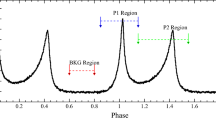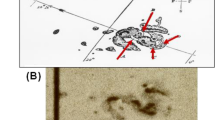Abstract
The goal of asteroseismology is to discern the physical conditions of stars by comparing observed pulsations with models.To obtain this goal, the observed pulsation periods and the spherical harmonics (n, ℓ, and m) need to match the theoretical model.Typically the most difficult part in this process is the identification of the pulsation modes in the observations.Multicolour photometry is one method that has proven useful for identifying pulsation modes.By observing stars through various wavebands, and comparing the amplitudes and phases, it is possible to determine the spherical harmonics.This contribution will emphasize the work of Watson (1988), which has since been applied to many different types of variable stars including δ Scuti (Garrido et al., 1990), γ Doradus (Breger et al., 1997), β Cepheid (Cugier et al., 1994), and EC 14026 (Koen, 1998) stars. I will also discuss the technique of summing spectra (especially UV) into various wavebands which are then used to identify modes as pioneered by Robinson, Kepler, and Nather (1982) and applied to white dwarf stars (Kepler et al., 2000).
Similar content being viewed by others
References
Baldry, I.K. et al.: 1999, MNRAS 302, 381.
Balona, L.A. et al.: 2001, MNRAS 321, 239.
Balona, L.A. and Stobie, R.S.: 1979, MNRAS 189, 649.
Breger, M. et al.: 2002, MNRAS 329, 531.
Breger, M. et al.: 1997, A&A 324, 566.
Buta, R.J. and Smith, M.A.: 1979, ApJ 232, 213.
Cugier, H., Dziembowski, W.A. and Pamyatnykh, A.A.: 1994, A&A 291, 143.
Dziembowski, W.: 1977, AcA 27,3, 203.
Garrido, R., Garcia-Lobo, E. and Rodriguez, E.: 1990, A&A 234, 262.
Hander, G. et al.: 2000, MNRAS 318, 511.
Kepler, So.O. et al.: 2000, ApJ 539, 379.
Koen, C. et al.: 2002, MNRAS 330, 567.
Koen, C.: 1998, MNRAS 300, 567.
Robinson, E.L. et al.: 1995, ApJ 438, 908.
Robinson, E.L., Kepler, S.O. and Nather, R.E.: 1982, ApJ 259, 219.
Wade, R.A. and Rucinski, S.M.: 1985, A&AS 60, 471.
Watson, R.D.: 1988, Phys. Space Sc. 140, 255.
Winget, D.E. et al.: 1991, ApJ 378, 326.
Author information
Authors and Affiliations
Rights and permissions
About this article
Cite this article
Reed, M. Multicolor Photometry for Mode Identification. Astrophysics and Space Science 284, 73–84 (2003). https://doi.org/10.1023/A:1023284612014
Issue Date:
DOI: https://doi.org/10.1023/A:1023284612014




